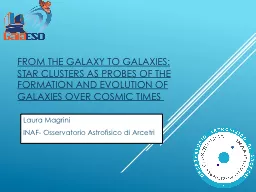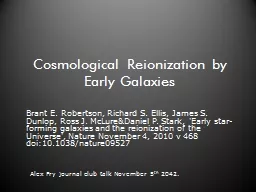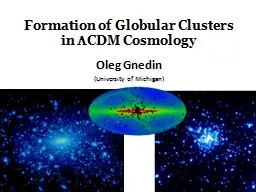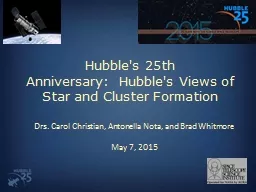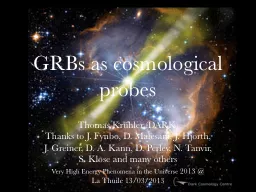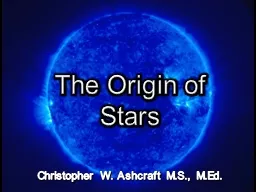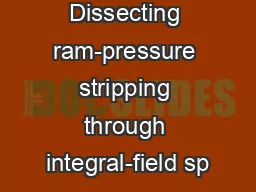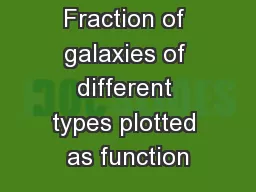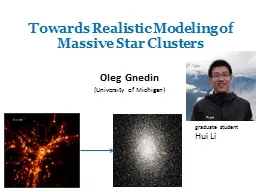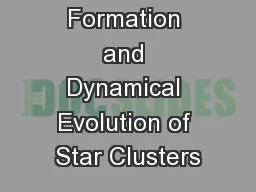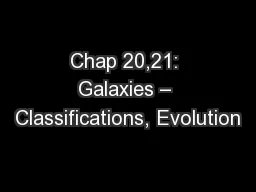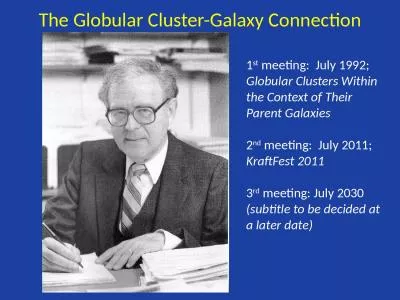PPT-From the Galaxy to galaxies: star clusters as probes of the formation and evolution of
Author : maniakiali | Published Date : 2020-06-25
Laura Magrini INAF Osservatorio Astrofisico di Arcetri In Our Galaxy Open clusters disc population Many 2200 known clusters even more new candidates in the
Presentation Embed Code
Download Presentation
Download Presentation The PPT/PDF document "From the Galaxy to galaxies: star cluste..." is the property of its rightful owner. Permission is granted to download and print the materials on this website for personal, non-commercial use only, and to display it on your personal computer provided you do not modify the materials and that you retain all copyright notices contained in the materials. By downloading content from our website, you accept the terms of this agreement.
From the Galaxy to galaxies: star clusters as probes of the formation and evolution of: Transcript
Laura Magrini INAF Osservatorio Astrofisico di Arcetri In Our Galaxy Open clusters disc population Many 2200 known clusters even more new candidates in the inner disc from infrared surveys . The Cosmic Time Machine. Astronomical telescopes can’t help viewing the past.. . Distance and time are always mixed in astronomical observations.. The finite speed of light means that we always see things after they have happened–a delay of 8 minutes for the Sun and about 12 billion years for the most distant galaxies we can observe. In other words,. Reionization. by Early Galaxies. Brant E. Robertson, Richard S. Ellis, James S. Dunlop, Ross J. . McLure&Daniel. P. Stark, 'Early star-forming galaxies and the . reionization. of the Universe', Nature November 4, 2010 v 468 . は階層的銀河形成論で説明. できるか?. Motohiro. . Enoki. Tomoaki Ishiyama (Tsukuba Univ.). Masakazu A. R. Kobayashi (Ehime Univ.). Masahiro . Nagashima. . (Nagasaki Univ. .). §1. Introduction. . CDM Cosmology. Oleg . Gnedin. (University of Michigan. ). What we knew before HST: globular clusters are old, dense, compact – a distinct type of stellar spheroids. Kormendy. (1985). Over 20 years the Hubble Space Telescope has revealed young massive star clusters in interacting and gas-rich galaxies.. Drs. Carol Christian, Antonella Nota, and Brad Whitmore. May 7, 2015. Stars /Star Clusters. Carol Christian. Stars form from gas and dust clouds. The clouds collapse due to gravity. Also the clouds can collide / compress. Thomas Krühler (DARK). Thanks to J. . Fynbo. , D. . Malesani. , J. . Hjorth. ,. J. Greiner, D. A. . Kann. , D. . Perley. , N. . Tanvir. , . S. . Klose. and many others. Very High Energy Phenomena in the . Christopher W. Ashcraft M.S., M.Ed.. Big Bang vs. Creation. Origin of Stars. Solar System: Evidence of Design. Age of the Cosmos. Are we being told all the evidence or just selected information to support a particular idea?. . Chris Haines . (Universidad de Chile). Paula . Merluzzi. , Gianni . Busarello. , . Amata. . Mercurio. . (Naples). , . Nobuhiro. Okabe . (IPMU). , Luis . Campusano. . (. U.Chile. ). ESO: Dissecting Galaxies Near and Far, 26th March 2015. Galaxy Morphology and Environment. Main relation – . E’s more common in clusters than field. f(E. ) = fraction of ellipticals . f(Sp. ) = fraction of spirals. regular, symmetric cluster – . f(E. Oleg . Gnedin. (University of Michigan. ). g. raduate student . Hui. Li. Star clusters are dominant components of active star formation:. they connect small-scale SF (local) and global processes in galaxies. Wen-Ping . Chen . National . Central . University . Census of Galactic open clusters. . Dynamical evolution of a star cluster. . Star clusters as targets and as tools. Outstanding issues. 2017 April 28 PMO . .. 1. First spiral nebula found in 1845 by the Earl of . Rosse. . Speculated it was beyond our Galaxy.. 1920 - "Great Debate" between Shapley and Curtis on whether spiral nebulae were galaxies beyond our own. Settled in 1924 when Edwin . Here’s the Story We’ll Unfold for You…. Hubble’s galaxy classifications: Spirals, . ellipticals. , irregulars. . Structural parts of galaxies: disk, halo, nucleus, bulge. Spiral arms – tracers of star formation. 1. st. meeting: July 1992;. Globular Clusters Within the Context of Their Parent Galaxies. 2. nd. meeting: July 2011;. KraftFest. 2011. 3. rd. meeting: July 2030 . (subtitle to be decided at a later date).
Download Document
Here is the link to download the presentation.
"From the Galaxy to galaxies: star clusters as probes of the formation and evolution of"The content belongs to its owner. You may download and print it for personal use, without modification, and keep all copyright notices. By downloading, you agree to these terms.
Related Documents

